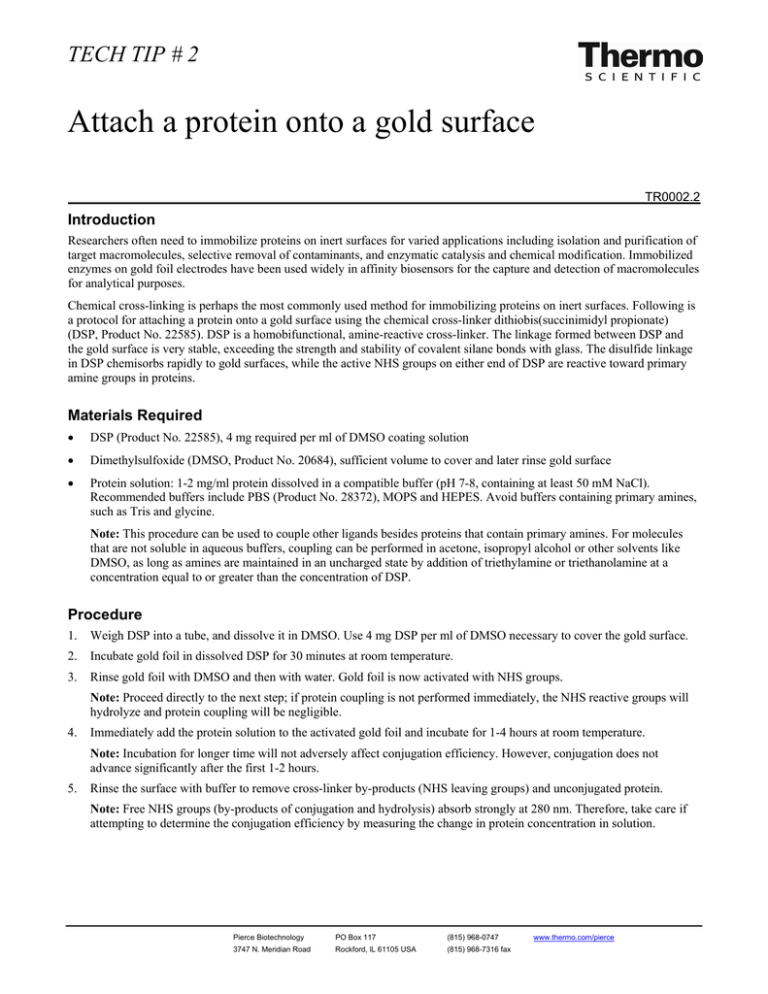
TECH TIP # 2
Attach a protein onto a gold surface
TR0002.2
Introduction
Researchers often need to immobilize proteins on inert surfaces for varied applications including isolation and purification of
target macromolecules, selective removal of contaminants, and enzymatic catalysis and chemical modification. Immobilized
enzymes on gold foil electrodes have been used widely in affinity biosensors for the capture and detection of macromolecules
for analytical purposes.
Chemical cross-linking is perhaps the most commonly used method for immobilizing proteins on inert surfaces. Following is
a protocol for attaching a protein onto a gold surface using the chemical cross-linker dithiobis(succinimidyl propionate)
(DSP, Product No. 22585). DSP is a homobifunctional, amine-reactive cross-linker. The linkage formed between DSP and
the gold surface is very stable, exceeding the strength and stability of covalent silane bonds with glass. The disulfide linkage
in DSP chemisorbs rapidly to gold surfaces, while the active NHS groups on either end of DSP are reactive toward primary
amine groups in proteins.
Materials Required
•
DSP (Product No. 22585), 4 mg required per ml of DMSO coating solution
•
Dimethylsulfoxide (DMSO, Product No. 20684), sufficient volume to cover and later rinse gold surface
•
Protein solution: 1-2 mg/ml protein dissolved in a compatible buffer (pH 7-8, containing at least 50 mM NaCl).
Recommended buffers include PBS (Product No. 28372), MOPS and HEPES. Avoid buffers containing primary amines,
such as Tris and glycine.
Note: This procedure can be used to couple other ligands besides proteins that contain primary amines. For molecules
that are not soluble in aqueous buffers, coupling can be performed in acetone, isopropyl alcohol or other solvents like
DMSO, as long as amines are maintained in an uncharged state by addition of triethylamine or triethanolamine at a
concentration equal to or greater than the concentration of DSP.
Procedure
1.
Weigh DSP into a tube, and dissolve it in DMSO. Use 4 mg DSP per ml of DMSO necessary to cover the gold surface.
2.
Incubate gold foil in dissolved DSP for 30 minutes at room temperature.
3.
Rinse gold foil with DMSO and then with water. Gold foil is now activated with NHS groups.
Note: Proceed directly to the next step; if protein coupling is not performed immediately, the NHS reactive groups will
hydrolyze and protein coupling will be negligible.
4.
Immediately add the protein solution to the activated gold foil and incubate for 1-4 hours at room temperature.
Note: Incubation for longer time will not adversely affect conjugation efficiency. However, conjugation does not
advance significantly after the first 1-2 hours.
5.
Rinse the surface with buffer to remove cross-linker by-products (NHS leaving groups) and unconjugated protein.
Note: Free NHS groups (by-products of conjugation and hydrolysis) absorb strongly at 280 nm. Therefore, take care if
attempting to determine the conjugation efficiency by measuring the change in protein concentration in solution.
Pierce Biotechnology
PO Box 117
(815) 968-0747
3747 N. Meridian Road
Rockford, lL 61105 USA
(815) 968-7316 fax
www.thermo.com/pierce
Related Thermo Scientific Pierce Products
21578
DTSSP, 50 mg, water-soluble form of DSP
20036
Bioconjugate Techniques, 2nd edition, Greg T. Hermanson, Academic Press, Inc., 2008.
Additional Information
Crosslinker selection guides and detailed instructions for individual products are available from our web site. A previous
version of this Tech Tip suggested using isopropyl alcohol to dissolve and coat the DSP on the gold surface, as directed in the
original publication by Katz1 and cited in the book by Hermanson et al.2 In practice, however, DSP is not soluble in isopropyl
alcohol; therefore, DMSO has been suggested as a more suitable solvent, in keeping with subsequent work by Katz. We offer
several of the crosslinker used by Katz in his experiments with gold electrodes. Water-soluble linkers or disulfide chemicals
(e.g., cystamine) other than DSP may be used to functionalize gold surfaces without using DMSO as the solvent.
References
1.
Katz, E.Y. (1990). J. Electroanal. Chem. 291, 257
2.
Hermanson, G. T., Mallia, A. K., and Smith, P. K. (1992). Immobilized Affinity Ligand Techniques, Academic Press Inc., p. 59
Current versions of product instructions are available at www.thermo.com/pierce. For a faxed copy, call 800-874-3723 or contact your local distributor.
© 2008 Thermo Fisher Scientific Inc. All rights reserved. Unless otherwise indicated, all trademarks are property of Thermo Fisher Scientific Inc. and its
subsidiaries. Printed in the USA.
Pierce Biotechnology
PO Box 117
(815) 968-0747
3747 N. Meridian Road
Rockford, lL 61105 USA
(815) 968-7316 fax
2
www.thermo.com/pierce



